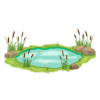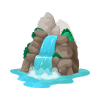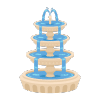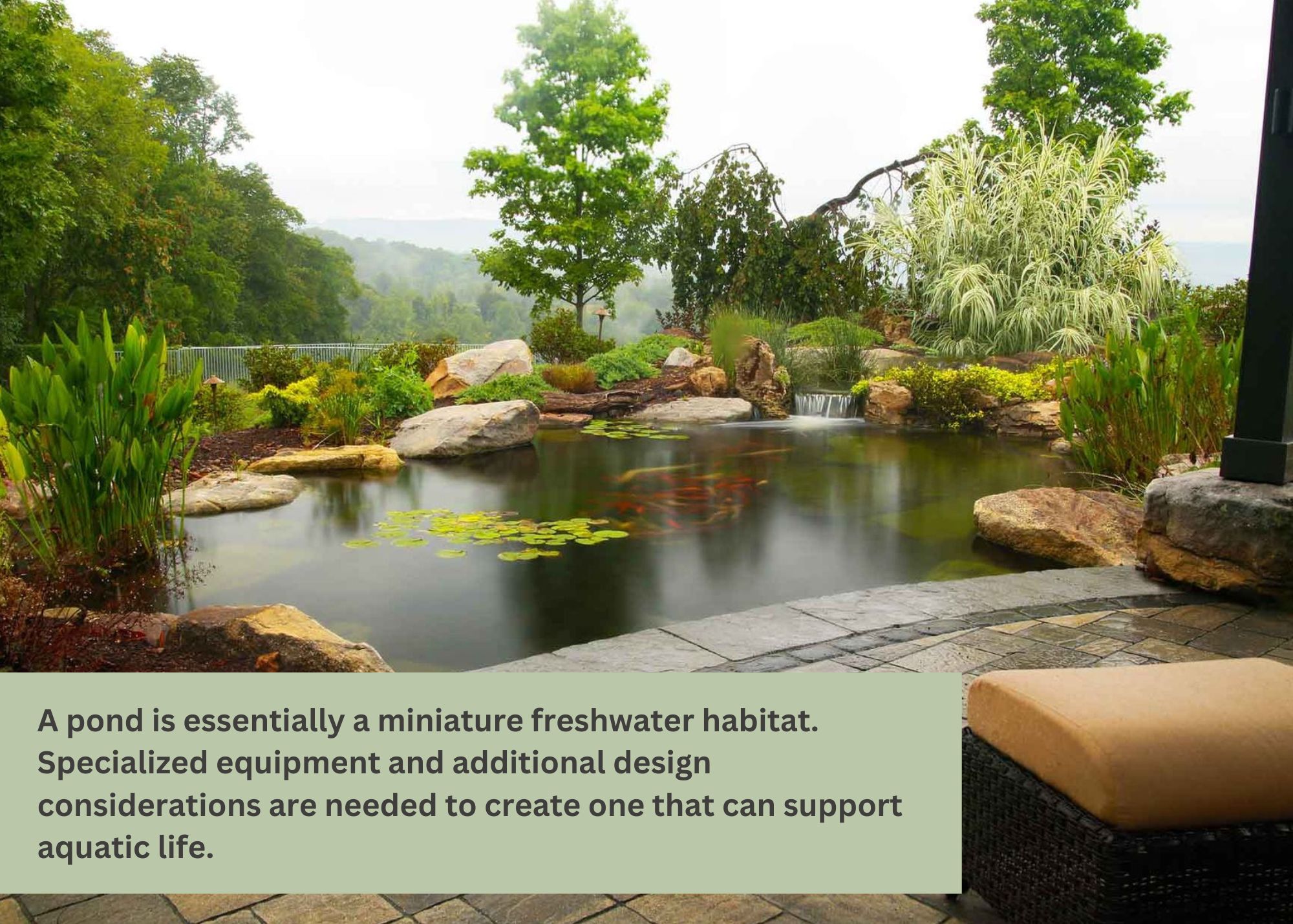Water features can transform any backyard or business environment into a serene and captivating space. The sound of flowing water soothes the senses, while the visual appeal of water elements enhances the aesthetic of your surroundings.
At Tussey Landscaping, we design and create exquisite outdoor living spaces that bring your backyard dreams to life. Whether you want to make a tranquil retreat at home or add an inviting touch to your business, we’ve got you covered!
In this blog, we’ll explore different water features, such as water gardens, ponds, pondless waterfalls, bubbling rocks, and fountains, and how they can elevate your space.
Water Gardens
Whether a tranquil pond with a cascading waterfall or an outdoor kitchen surrounded by aquatic elements, nothing enhances the serenity and beauty of your backyard quite like a thoughtfully crafted water garden.
Water gardens (also known as aquatic gardens) combine aquatic plants and water features to create a mini-ecosystem. They are perfect for those who love gardening and want to incorporate water into their landscape.
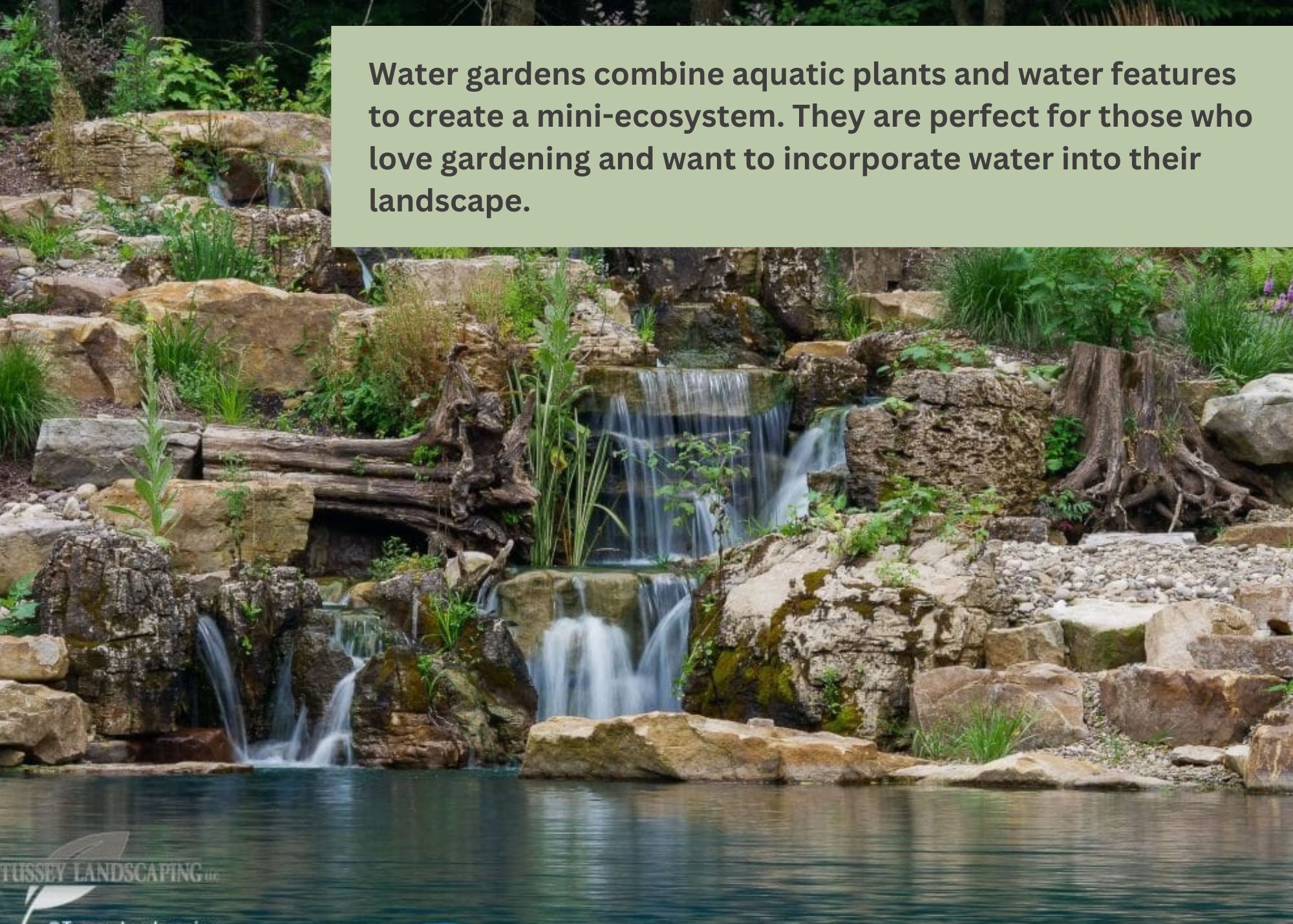
Water gardens can be as simple or elaborate as you desire. The primary focus is on plants, but they can also house waterfowl or ornamental fish, depending on the size.
Water gardens provide many benefits to your backyard:
Biodiversity:
Even if you don’t put any fish in it, water gardens attract a variety of wildlife, including birds, frogs, and beneficial insects.
Aesthetic Appeal:
The combination of water, plants, and wildlife creates a visually stunning display. A great example of a beautiful garden is right here in Pennsylvania, at the Phipps Conservatory.
Relaxation:
The sound of water and the sight of vibrant plants provide a calming effect. There is something about hearing waterfalls, watching fish swim, and smelling beautiful water plants that just eases the soul.
When planning for a water garden, you should consider the following:
- Space: Ensure you have enough space for the size of the water garden you want. A larger pond will be necessary to attract wildlife, especially birds.
- Sunlight: Most aquatic plants require sunlight, so choose a location that receives adequate light. However, too much sunlight can trigger algae blooms if there is too much nutrient pollution or organic waste in the water, such as fertilizer runoff from lawns and animal waste. Add floating plants like lilies and lotus to provide shade and submerge plants such as anacharis and hornwort to release oxygen into the water.
- Maintenance: Regular maintenance is necessary to keep the water and plants healthy. By removing dead plants, not overfertilizing plants, or overfeeding fish, you can reduce the likelihood of an algal bloom.
Finally, still water can lead to a film developing on the water's surface, poor nutrient circulation, and mosquitoes. A fountain or waterfall can aerate and keep the water moving.
Ponds
Ponds are a classic choice for adding tranquility to your space. From small, decorative ponds to larger, natural-looking bodies of water, a well-designed pond is an idyllic haven where you can relax, entertain guests, and reconnect with the natural world. Ponds offer a habitat for fish and aquatic plants, creating a dynamic and lively environment.
The natural beauty of a pond has several benefits:
- Versatility: Ponds can be customized to fit any size or style preference. However, consider the size of the pond – the larger the pond, the more robust the ecosystem. Filtration systems can help maintain the delicate balance of life in the pond.
- Wildlife Attraction: Ponds can be a habitat for plants, frogs, insects, birds, and any fish inhabiting the pond, turning your space into a tiny wildlife sanctuary. The sound of birds during the day and frogs in the evening provide relaxation even when you’re not looking at it!
- Visual Impact: A well-designed pond with vibrant colors and pleasant sounds can be a focal point in your landscape.
You might wonder about the difference between a water garden and a pond. While both make wonderful additions to your backyard, a water garden is primarily intended for growing aquatic plants. On the other hand, a pond is mainly a freshwater wildlife habitat (though you don’t want to put too many fish in your pond).
The ecosystem will also differ – a pond needs to handle significantly more waste than the fish would produce and needs help from water filtration systems, which require maintenance. A water garden’s plants help process fish waste, but the water can only handle a small fish population due to the delicate balance of such a small ecosystem.
Ponds also need to be deeper to help the fish better withstand changes in temperature and weather conditions. A deeper pond also helps support a greater diversity of aquatic life. In areas with hotter summers, a deep pond stays cooler than a shallow pond, providing a refuge for fish and other aquatic creatures.
Pondless Waterfalls
If you enjoy the serenity and charm of a waterfall but don’t have the need or space for a water garden or pond, how about installing a pondless waterfall? They are an excellent option for those who want the beauty and sound of a waterfall without the maintenance of a pond. These features include a recirculating waterfall and stream without a standing body of water.
Pondless Waterfalls give you all the benefits of a tranquil waterfall without the hassle because they’re:

- Low Maintenance: Less maintenance is involved; thus, it is more economical to do without a pond. All you have to do is ensure that the water circulation system works.
- Space-Saving: They require less space than traditional ponds and will easily fit in with your existing landscaping with minimal modification.
- Safety: Without standing water, they are safer for children and pets, and as a result, do not increase your insurance premium. The lack of standing water is also a deterrent for pests such as mosquitoes.
“Well, that’s easy enough!” you might say. Here are some critical considerations before chasing a pondless waterfall:
- Water System: Ensure you have a reliable pump and reservoir system to keep the water flowing. You will need a sufficiently-sized reservoir placed under the waterfall structure to cycle the water from the rock to the ground and back up to the top of the waterfall again.
- Design: Consider the natural flow and placement to create a realistic look. Surround the waterfall with similar-looking rocks to make it look like a natural formation.
- Energy Use: Be aware of the pump's energy consumption. At Tussey Landscaping, we take pride in all of our pumps being extremely efficient!
Bubbling Rocks
Bubbling rocks are a unique and modern water feature that involves water bubbling up through a rock or series of rocks and operating on the same principle as a pondless waterfall.
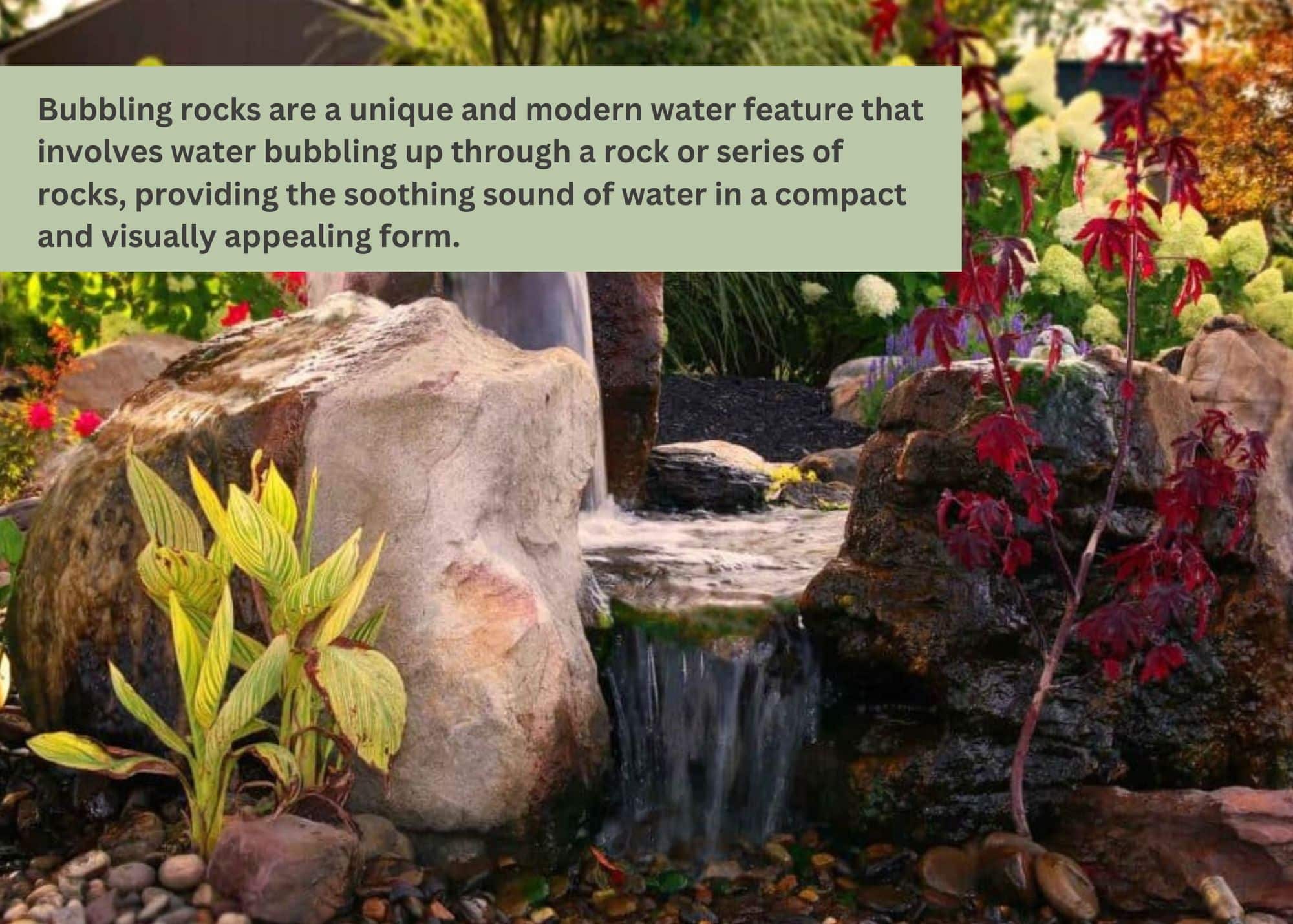
They provide the soothing sound of water in a compact and visually appealing form. They are small and ideal for homeowners who like the appeal of moving water but prefer something more subtle.
Bubbling Rocks offers the following benefits:
- Compact: Ideal for small spaces or as an accent feature. Bubbling rocks are also great watering holes for bees and butterflies, so it’s a perfect complement to a butterfly garden!
- Unique Aesthetic: Offers a modern and natural look. Surround your bubbling rock with smaller river rocks and plants for visual appeal.
- Easy Installation: Typically easier to install than larger water features.
When selecting a bubbling rock, your tiny water feature needs some big considerations:
- Rock Selection: Bubbling rocks come in various colors, so choose rocks that complement your landscape design. If you’re unsure what color to choose, take a few pictures of your backyard and the general area where you intend to install the rock. Need help making the right choice? Just give us a call at Tussey Landscaping, and we’ll happily help you!
- Water Source: Like a pondless waterfall, you must ensure a consistent water source and reservoir for continuous bubbling.
- Lighting: Consider adding outdoor lighting for a dramatic nighttime effect.
Fountains
Fun fact: Did you know that the world’s largest fountain is the Palm Fountain in Dubai? Its 128 super shooters propel water up to 344 feet in height and cover 78,867 square feet.
You don’t need anything that big, but you can still get one that will be a commanding presence in your backyard! Fountains are a timeless water feature that suits traditional and modern landscapes.

Enjoy the tranquility of a fountain in various styles, from classical tiered fountains to sleek, contemporary designs to match your environment.
When you install a fountain, you get:
- Versatility: Available in various styles, sizes, and materials, from a modernist fountain made of metal and stone to an ornate, classical garden fountain.
- Sound: Water cascading from a fountain can be very soothing. Research indicates that flowing water's sound significantly reduces stress.
- Focal Point: Can serve as a stunning centerpiece for your space.
A fountain is attention-catching, so consider these factors before you spring for one:
- Style: Choose a style that complements your overall landscape design. Fountains also benefit from lightning and can create spectacular displays of water and light in the dark.
- Material: Consider durable materials for longevity for your fountain, such as stone or metal.
- Maintenance: Regular cleaning is necessary to prevent algae and mineral buildup.
Choosing the Right Water Feature
When deciding which water feature to add to your backyard or business, consider the following factors:

Space: Whether it’s a majestic fountain or an understated bubbling rock, assess the available space and choose a feature that fits well.
Budget: Determine your budget for installation and maintenance. Small water features like bubbling rocks and pondless fountains require very little maintenance, while fountains require cleaning. Ponds and water gardens need the most maintenance, especially during the crucial period when the ecosystem is slowly establishing itself.
Purpose: Decide whether you want the feature for aesthetic, relaxation, or ecological benefits.
Climate: Consider how the local climate will affect the feature, especially in maintenance. If you have water features with mechanical components, such as pumps, you may need to winterize them for cold weather.
If fish are involved, you’ll need to ensure the water is deep enough to prevent the water from getting too hot during the summer or freezing during the winter.
Safety: Consider water features that don’t have standing water at the base to prevent pets and small children from accidentally drowning. Ponds can pose drowning threats, so fence them off if there are small pets or children around.
For electrically-powered water features, ensure a professional electrician does all electrical installation and has passed inspection.
Conclusion
Incorporating a water feature into your backyard or business can significantly enhance the beauty and ambiance of the space. Whether you opt for a lush water garden, a serene pond, a dynamic pondless waterfall, a modern bubbling rock, or a classic fountain, each option offers unique benefits.
At Tussey Landscaping, we’ve been making backyard dreams come true since 1991. We believe every family deserves their dream backyard where they can hang out and make memories together, and we’re ready to help you transform your space into a captivating retreat.
Feel free to check out some examples of water features we’ve or done or contact us today to get started!


